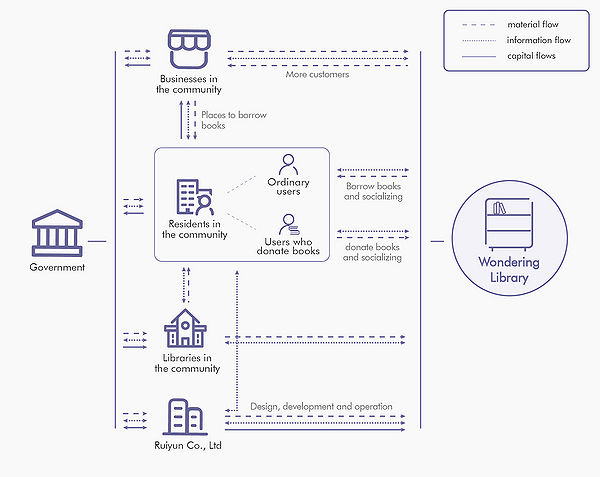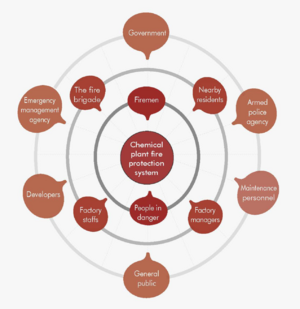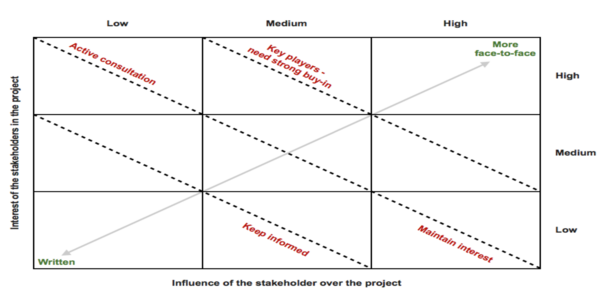Stakeholder Identification and Categorization
Ziwei Chen (Talk | contribs) (→Application) |
Ziwei Chen (Talk | contribs) (→Application) |
||
| Line 50: | Line 50: | ||
This is a way of positioning actors that could facilitate the practice of a people-centred approach<ref name="ref7"/>. | This is a way of positioning actors that could facilitate the practice of a people-centred approach<ref name="ref7"/>. | ||
| − | [[File:Stakeholder_map_of_Chemical_plant_fire_protection_system.png|300px|middle|Figure 2: stakeholder map of Chemical plant fire protection system.]<ref name="ref7"/> | + | [[File:Stakeholder_map_of_Chemical_plant_fire_protection_system.png|300px|middle|Figure 2: stakeholder map of Chemical plant fire protection system.]]<ref name="ref7"/> |
A decision was made that the head of the communication department would select its position on the stakeholder map. Other stakeholders would do the same, resulting in a current and future stakeholder map. After that, the focus of the map shifted to service recipients, migrants, and local residents instead of public institutions. | A decision was made that the head of the communication department would select its position on the stakeholder map. Other stakeholders would do the same, resulting in a current and future stakeholder map. After that, the focus of the map shifted to service recipients, migrants, and local residents instead of public institutions. | ||
Revision as of 22:23, 21 March 2022
Contents |
Abstract
‘Stakeholders’ generally means any group or individual who can affect or is affected by the achievement of the organization’s objectives. [1] Stakeholder analysis is an essential part of project management, which can help recognize the people related to the project, so that project managers can analyze the impacts of different stakeholders, get more support and resources to facilitate the project. It is important to analyze stakeholders early in the project because it can provide a guide to decide the direction for a project.
This article explains how to identify and categorize the stakeholders by introducing the definition, purposes, applications, and limitations, aiming to provide readers with a guide to apply the methods.
Definition
Stakeholder is a group, corporate, organization, member, or system that affects or can be affected by an organization's actions. [2]. Stakeholders can also be defined as actors who have an interest in the issue under consideration, who are affected by the issue, or who – because of their position – have or could have an active or passive influence on the decision-making and implementation processes[3].
Stakeholder analysis comprises different methods, processes and has developed a lot of tools utilized in different industrials and business structure.
Whatever approach is used, there are three essential steps in stakeholder analysis:
1) Identifying the key stakeholders and their interests.
2) Assessing the influence of, importance of, and level of impact upon each stakeholder;
3) Identifying how best to engage stakeholders
[4].
The processes of stakeholder identification and categorization mainly belongs to the first two steps.
Purpose
Stakeholder analysis has many benefits for projects, not only in improving the satisfaction of those involved with or related to the project, but also in the progress and outcomes of the project.
On the one hand, stakeholder engagement can achieve mutual understanding and trust between the organization and the stakeholders in order to achieve a comfortable relationship of coexistence and mutual success. [5] Considering the expectation and concerns from people related to the project is important to increase the reputation of the project and influence the process. Meanwhile, some stakeholders have veto power to some key decisions, which can also impact the execution and results. So, it is essential to figure out the key stakeholders, the impacts from different stakeholders, the purpose of engaging them, and their expectations.
On another hand, it can provide project managers with more comprehensive views to estimate risks that could happen in the future. Firstly, transitions between phases of a project have significant impacts on stakeholders. For example, project ramp-up from scoping to construction is particularly dramatic. There is usually a sharp increase in employees, construction activity, traffic, dust, noise, and other impacts. The reverse is true for transition from construction to operations where there could be job losses and a decrease in the local economy.[5] Getting key stakeholders ready for project transitions is essential to avoiding unnecessary concerns and managing project impacts. Secondly, getting information from stakeholders has a great impact on defining the scope of a project because project managers can more accurately understand economic planning, the needs of users and communities, the impact assessment, and find opportunities to optimize the project.
Application
The identification and classification processes are important steps in stakeholder analysis, and stakeholder engagement is a complex process that needs to determine the scope, impact, and workload. That should be comprehensive and flexible so that subsequent cooperation and communication can be smoothly advanced. It is necessary to use some tools to analyze. The purpose of these tools is not limited to representing or communicating, these visualization tools can also work as “conversation facilitators”, they can be used collaboratively to trigger discussion in a management process. In this way, they may support the collaboration of different people in multiple ways. [6]
This article focuses on three tools to mine and sort out stakeholders and find their influence on the project, including stakeholder map (circle style), interest/influence matrix, and system map.
Stakeholder map (circle style)
Introduction
Stakeholder map is a representation of all the stakeholder involved in a project, aimed at clarifying roles and relationships[7]. In addition to identifying stakeholders, stakeholder maps are frequently used to estimate or forecast their influence. People from different organizations could use the stakeholder map as a discussion tool during early project meetings to express their points of view and to gain mutual understanding.
Application
A public institution dealing with migrants in Geneva, Switzerland, used a design team to improve their service offering. As a result of the stakeholder map, a new form of dialogue between the public institution and stakeholders was developed. The problem of previous phase is that designers are difficult to access and involve end-users, so the project team created a mini workshop using the stakeholder map to establish a mutual understanding by the conversation and define a new direction for phase two. Having stakeholders engage in a dialogue about this issue, clarifying the organizational structure, and opening up a new dialog with the public institution about stakeholders' involvement were the purposes. They envisioned an ecosystem with a user/people/citizen-centred perspective where all newcomers - recipient of the public institution and others - would have the most central role together with local citizens.[7] It is likely that small, local organizations that already offer numerous services and activities will play an important role in creating bridges between recipients and local citizens, communicating information, and organizing activities. Even though designers are already in the second circle, they'd be close to the center when they're building the service, testing it, and working with recipients and local citizens. By placing the institution card next to the designer card, this suggests a more supportive role than a leadership role, allowing designers direct access to users/citizens. This is a way of positioning actors that could facilitate the practice of a people-centred approach[7].
A decision was made that the head of the communication department would select its position on the stakeholder map. Other stakeholders would do the same, resulting in a current and future stakeholder map. After that, the focus of the map shifted to service recipients, migrants, and local residents instead of public institutions.
The details unearthed from these stakeholder maps are
1) The project team tends to mix up who should actually benefit the project with who funded and facilitated it.
2) The public employees expressed a desire for more solidarity, exchanges, and equality among themselves.
3) The project was open to people other than the public institution, and the ambassador was able to moderate communication between the recipients and other migrants as well as locals.
[[File: .png|600px|middle|Figure 2: .....][7]]
Stakeholder map (interest / influence matrix)
Depending on the specific need, the map can be created as a simple quadrant with two axis (level of influence and level of interest or engagement in the process).
System map
A system map is a synthetic representation that shows in one single frame all the different actors involved in a service delivery, and their mutual links. The system map clarifies how the different service components and roles are connected one to the other, highlighting the values they exchange [8].
The use of system map is a well-established tool in detect gaps and opportunities in a project.

Limitations
Although it is important to engage stakeholders and get their feedback, it is not always beneficial as it may influence and alter the stakeholder’s position, reducing the utility of the analysis. Feedback of outputs may also be inappropriate if the stakeholders are in a position to influence or control the outcome of the analysis, where a preliminary assessment is not favorable to them.[9].
Conclusion
Stakeholder engagement has a large range, not all can be included and considered. The challenge for a project is to listen to the “right” stakeholders in the right way and make the right decision depending on the topic. This is especially relevant when it comes to corporate responsibility for sustainability. Balancing different interests, identify the types of stakeholders and deciding how to communicate with them is eventually forms the foundations for the result of the project.
References
- ↑ R. Edward, Freeman, and Mcvea John. a Stakeholder Approach to Strategic Management.,ResearchGate, Jan. 2001, SSRN Electronic.
- ↑ Wikipedia Contributors. . Wikipedia, Wikimedia Foundation, 9 Oct. 2018, en.wikipedia.org/wiki/Stakeholder. Accessed 11 Dec. 2018.
- ↑ Varvasovszky, Z. A Stakeholder Analysis., Health Policy and Planning, vol. 15, no. 3, 1 Sept. 2000, pp. 338–345
- ↑ Golder, B, and Gawler, M. Cross-Cutting Tool Stakeholder Analysis. World Wildlife Fund, 1 Oct. 2005.
- ↑ 5.0 5.1 Mcphee, Wayne, and Sabrina M Dias. Integrating Sustainability into Major Projects: Best Practices and Tools for Project Teams. Hoboken, Nj, John Wiley & Sons, Inc, 2020
- ↑ Gaver, Dunne and Pacenti, 1999; Eriksen et al., 2014; Sangiorgi, Patricio and Fisk, 2017, cited in Mcphee, Wayne, and Sabrina M Dias. Integrating Sustainability into Major Projects: Best Practices and Tools for Project Teams. Hoboken, Nj, John Wiley & Sons, Inc, 2020.
- ↑ 7.0 7.1 7.2 7.3 7.4 Giordano Fanny, Morelli Nicola, De Götzen Amalia, Hunziker Judith."The stakeholder map: A conversation tool for designing people-led public services", 2018
- ↑ Nicola Morelli, "New representation techniques for designing in a systemic perspective, paper presented at Design Inquires", Stokholm, 2007.
- ↑ Varvasovszky, Z. "A Stakeholder Analysis." Health Policy and Planning, vol. 15, no. 3, 1 Sept. 2000, pp. 338–345

